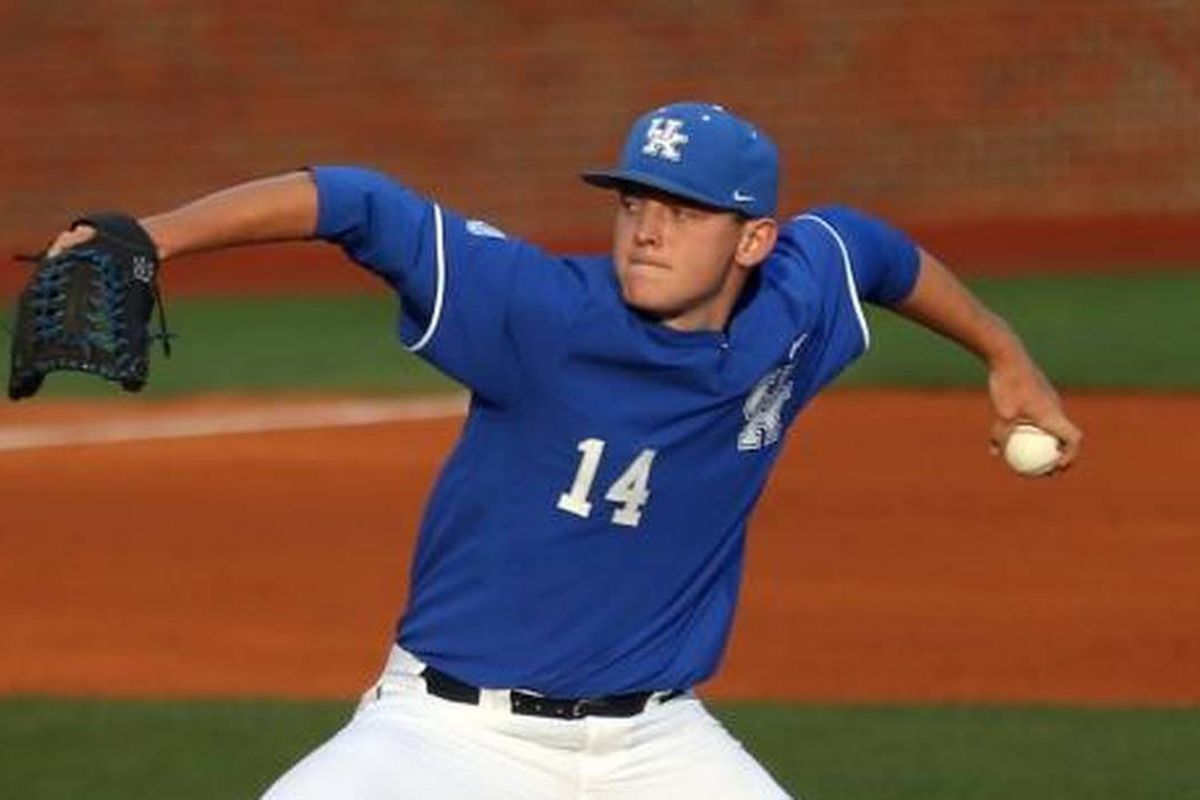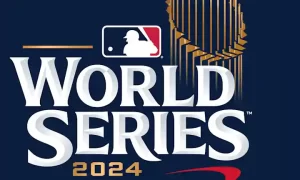Top 10 College Pitchers in the 2019 MLB Draft

The 2019 MLB Draft is quickly approaching and Off the Bench is proud to present a series of Top 10s, running through the various groups that MLB clubs will be picking from- today, it’s the College Pitchers.
We ran our Top 10 College hitters and Top 10 High School hitters in the MLB Draft last week.
Before we get started I just wanted to mention how close the top 4 is. It’s really a matter personal preference, (the same can be said about the high schoolers, which we’ll discuss in another post) and at this point a lot of this is projection. I just went with who I felt confident in.
#1 ZACK THOMPSON, LHP, KENTUCKY
Zack Thompson is one of the best pitchers in this draft class and he has been a lot of fun to watch pitch this spring as he has dominated the SEC. These are his stats through 10 starts in SEC conference play: 5-1, 67.1 IP, 2.27 ERA, 1.06 WHIP, with 93 strikeouts and a 12.4 K/9.
He has a chance to continue the streak that started in 2016 of top pitchers in the draft coming out of the SEC. The only concern for scouts has been some injury history , but he has looked strong all this spring. Last summer he was a member of Team USA.
Size: 6’3″, 225.
Stuff: He is a four pitch pitcher who projects to have at least 4 above average or better pitches. His fastball sits in the Low 90s and tops out at 96. He also throws a Low 80s slider. Both his fastball and his slider are above average to plus pitches. He also throws a curveball that shows glimpses of being an above average or better pitch. Thompson also throws a changeup but it is a work in progress. He has a nice clean three quarters delivery and has shown improved control this spring.
2019 and beyond: Zach Thompson has the ability to be a middle of the rotation starter with the upside of a possible front of the rotation starting pitcher, but he has had health issues in the past and it might scare some teams away from taking him in the Top 10. He has a good chance to be the top arm in this class and should be able to move quickly as long as he can stay healthy.
#2 NICK LODOLO, LHP, TCU
Back in 2016 Nick Lodolo was drafted with the 41st overall pick in the draft and opted not to sign and headed to TCU. Fast Forward to 2019, and Lodolo is a top pitcher in this year’s draft class. In 2019 his BIG XII conference stats through 8 starts are: 2-2, 3.00 ERA, 1.18 WHIP, through 51 IP, and he has 61 strikeouts and a 10.8 K/9. I feel that it is very close among the top two pitchers coming out of college and it’s more of a preference thing when deciding between the 2.
Size: 6’6″, 180
Stuff: Lodolo is a three pitch pitcher who projects to have at least 3 above average to plus pitches. He throws a fastball with good sink that usually sits around 90-94 mph and tops out at 96. He throws a low 80s slider that is a still a work in progress but it has started to become more of a solid pitch. He throws a changeup that has good action and looks to a be solid to plus pitch in the future. He should have above average or better control and he is tall and projectable.
2019 and beyond: Lodolo might be the first pitcher drafted this year but he might not move as fast as most of the top college pitchers in their draft class would. He is tall and projectable and would be worth the wait if he can turn into the pitcher scouts believe he can be. He currently projects to a potential middle of the rotation starting pitcher.
#3 JACKSON RUTLEDGE, RHP, SAN JACINTO JC*
Jackson Rutledge is the best junior college draft prospect since Bryce Harper back in 2010. In 2017 he had the talent to go in the top 5 rounds but he was a strong recruit for Arkansas and he went undrafted. He pitched only 15.2 innings as a Freshman for Arkansas and transferred afterwards.
Size: 6’8″, 240
Stuff: Rutledge is a four pitch pitcher with a chance to have 3 above average to plus pitches. He has a plus fastball that sits 94-97 mph and tops out at 99 and he is able to maintain that velocity deep into games. His fastball at times lacks movement which could be a concern but the velocity is some of the best in this draft class. He also shows flashes of having a plus curveball and a plus slider although at times he has trouble locating them.
He throws a changeup but that needs more work and might just be an average pitch. He has trouble throwing strikes at times and will probably only develop fringe-average command.
2019 and Beyond: Rutledge projects to be a mid-rotation starter if he can improve his secondary pitches and control. He should be drafted in the Top 15-20 picks and if a team really likes him they could take him even earlier than that.
#4 ALEK MANOAH, RHP, WEST VIRGINIA
For the first 2 seasons of his college career he pitched more out of the bullpen, but last summer he pitched as a starter in the Cape Cod League and ended up leading the league in strikeouts. This year as a Friday starter for West Virginia he has performed well enough to rank among the top college pitchers in this year’s draft class. His BIG XII Conference stats this year through 8 starts are: 2-2, 1.75 ERA, 0.85 WHIP, 61.2 IP, with 76 strikeouts and an 11.1 K/9.
Size: 6’6″, 260
Stuff: Alek Manoah is a three pitch pitcher with the chance to have 3 above average or better pitches. His fastball is his best pitch and currently sits between 94-97 mph with good sink and it could develop into a plus to double plus pitch. His second best pitch is his slider which shows flashes of being an above average to plus pitch. His third pitch is a changeup which he hasn’t thrown much but he has had success with when he has thrown it in the past and it could develop into an above average pitch. Manoah has struggled with control in the past but he has shown above average control this spring and projects to have above average control in the future. Because he was a reliever his first two seasons he still has plenty of upside and projectability.
2019 and beyond: Alek Manoah is one of the top right handed pitchers and he might have more left in the tank as he was a college reliever up until this year. His plus fastball and power slider as well as his ability to pitch well this spring should be enough to hear his name called in the first half of the first round, maybe even the top 10.
#5 GEORGE KIRBY, RHP, ELON
Most players from Elon don’t garner much attention but after George Kirby posted a 24-1 Strikeout to Walk Ratio as a reliever he got scouts’ attention. This year he has been among the D-1 leaders with a 17.5 to 1 strikeout to walk ratio.
Size: 6’3″, 205
Stuff: Kirby is a four pitch pitcher with a chance to have 4 above average pitches with above average to plus control. Kirby’s best pitch is a low 90s fastball that has topped out at 98 and looks to be a plus pitch, he has the chance to add even more velocity as he gains strength. His curveball and slider are projectable pitches that scouts feel have a chance to be above average to plus. He throws a changeup that has a chance to be above average.
2019 and beyond: George Kirby has good control and He looks to be a mid-rotation starter with upside depending on how well he can develop his secondary pitches and command them which will be his primary focus as a pro.
#6 ISAIAH CAMPBELL, RHP, ARKANSAS
Isaiah Campbell‘s father served in the Air Force so as a child Isaiah moved around the world quite a bit. He was born in Portugal and if he makes it to the majors he would be the first Portuguese born player to play in the majors since 1875. He also spent time in Germany and Turkey while he was growing up. Last year as a draft eligible Sophomore he was selected in the 24th Round by the Angels but decided to not sign and it proved to be a good decision as he has had a much better year this year. His stats through 10 starts in SEC Conference play look like this: 7-1, 2.30 ERA, 0.93 WHIP, 66.2 IP, and 64 strikeouts with an 8.6 K/9.
Size: 6’4″, 225
Stuff: Isaiah Campbell is a four pitch pitcher with a chance to have 4 above average pitches. His fastball is his best pitch and it has a great chance to be a plus pitch, it currently sits between 91-95 mph and tops out at 98 mph. His best secondary pitch is a low 80s slider that projects to be an above average to plus pitch and at times it will seem like a cutter.
Campbell also throws a splitter that in time could develop into an above average pitch. His fourth pitch is a curveball that he doesn’t throw that much but he is able to use it to keep hitters off balance it could develop into a possible average or better pitch in time. Scouts feel he has the ability to develop above average control.
2019 and beyond: Isaiah Campbell has the upside of a #3 starting pitcher and he has improved a lot from last year to this year so he has a chance to continue to get better and might move faster and have a better chance to be a starter than some of the other college pitchers in this years draft class. He has the potential to go on Day 1.
#7 SETH JOHNSON, RHP, CAMPBELL
Seth Johnson was more of an unknown coming into this season as he had been a shortstop while playing for Louisburg (NC) JC and had only 6 innings pitched in his first 2 seasons of JUCO. He is considered to have one of the best deliveries in this year’s class.
Size: 6’1″, 195
Stuff: Seth Johnson is a four pitch pitcher with the chance to have at least 3 above average pitches. His best pitch is his fastball that projects to be a plus pitch and currently sits around 91-95 mph topping out at 98 this year. His best secondary offering is his slider that at times shows flashes of being an above average to plus pitch but is inconsistent and still very much a work in progress as he hasn’t had much experience pitching. His other two pitches, the curveball and the changeup are still very raw at this stage and will need to work on improving them at the next level. Due to his inexperience he has had trouble showing consistency and at times has struggled with his control but scouts feel that he could develop above average control in the future.
2019 and beyond: Johnson is an impressive but ultra raw talent and could take longer than other college pitchers to develop. Whichever team drafts him believes in his upside but will have to be patient with him as he develops. He has a good chance to go on Day 1.
#8 MATT CANTERINO, RHP, RICE
Matt Canterino first burst onto teams radars back in 2017 when as a Freshman he was Rice’s #1 Pitcher and led Conference USA in strikeouts with 111 over 96 innings. He is one of only two college pitchers to have struck out 100 or more three straight seasons. He played for Team USA last summer and was a Cape Cod League All-Star.
Size: 6’2″, 205
Stuff: Canterino is a four pitch pitcher with a chance to have 4 above average pitches, and three of them could develop into plus pitches. His fastball usually sits at 90-93 mph and tops out at 96 mph it projects to be an above average to plus pitch. His best pitch is his mid 80s slider that should develop into a plus pitch. He also throws a curveball that could develop into an above average pitch to plus pitch. He also throws a changeup but hasn’t used it very much because he’s been so effective with his other secondary pitches. He has an unorthodox delivery and uses a lot of effort which leads scouts to question his ability to be a long term starting pitcher. He also shows the potential for above average to plus control.
2019 and beyond: A college pitcher who seems like he could be a fast mover thanks to his above average to plus control and ability to have 3 plus pitches. Matt Canterino has one of the safer floors as a back end of the rotation starter with upside which means he has a good chance to hear his name called on Day 1.
#9 JOHN DOXAKIS, LHP, TEXAS A&M
John Doxakis has had some pretty big moments during his college career. As a freshman he got the win that helped send Texas A&M to the College World Series. In his sophomore season he outpitched Casey Mize last year’s first overall pick in their matchup at the SEC Tournament. In 2019 his SEC conference stats look like this, 4-2, 2.23 ERA, 1.23 WHIP, through 64.2 IP with 62 strikeouts for an 8.6 K/9.
Size: 6’4″, 215
Stuff: Doxakis is a three pitch pitcher with the chance to have 3 above average or better pitches. His fastball should become an above average to plus pitch in time thanks to his ability to command it to both sides of the plate, it currently sits in the 88-93 mph range. He throws two really good secondary pitches in his slider and changeup. He doesn’t overpower hitters with his stuff but it plays well due to his ability to command most of his pitches and he projects to have above average to plus control.
2019 and beyond: Doxakis has been the #1 starter for Texas A&M and hasn’t disappointed. Even though he might never have the ability to dominate hitters with his stuff he still can be an effective pitcher thanks to his plus command. He profiles as a back of the rotation starter but still has a pretty good chance of going on Day 1.
#10 DREY JAMESON, RHP, BALL STATE
Drey Jameson is the top draft eligible Sophomore player in this year’s draft. He finished 2nd in Division I in strikeouts with 97 in 72 innings pitched (12.1 K/9) last year as a Freshman. This spring he got a chance to face Stanford which is one of the best teams in the country and no hit them through 6 innings.
Size: 6’0″, 165
Stuff: Jameson is a four pitch pitcher with a chance to have four above average or better pitches. His fastball has a chance to be a plus to double plus pitch and it currently sits 93-96 mph and tops out at 98 mph, he has shown the ability to maintain that velocity deep into his starts. He throws two breaking balls that project as above average to plus offerings in his curveball and his slider. He also throws a changeup but it’s a work in progress because he hasn’t had to use it much. Scouts feel he has a better future as a reliever. He should develop average to above average control.
2019 and beyond: Drey Jameson has one of the best fastballs in this year’s draft class and he is still young enough to get stronger and he might possibly have a chance to start even though he profiles better as a future power reliever, one which might be able to throw 100 mph or harder someday. He has a good chance to go Day 1.
-James Weisser
















